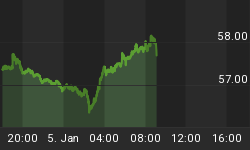The US dollar is the world's reserve currency. And that isn't likely to change in any radical way, anytime soon. Unless there is some kind of calamitous implosion of the dollar. I am talking about outright rejection and repudiation. And that could happen. The problem is that there isn't another currency that could likely take its place.
By the time that possibility becomes a reality, any possible candidates would likely be in worse shape. This includes the Euro and Chinese Yuan.
All currencies are substitutes for real money, i.e. gold. And because all governments inflate and destroy their own currencies, the possibility of gold reasserting itself as the international medium of exchange increases considerably under the aforementioned conditions.
But, a lot of bad stuff has to happen before we get to that point. And governments around the world have too much at stake to capitulate when it comes to ceasing to issue 'funny money'.
So, for the time being, lets focus on things as they are. Which leads us back to the title of this article.
Gold is priced in US dollars and trades in gold are settled in US dollars because of the hegemony of the dollar and its role as the world's reserve currency. But what does that mean to others around the world? For example, those who live and work in Germany (euro), Japan (yen), China (Yuan)?
It means that holders of any non-USD currency who want to exchange it for gold, must first exchange it for US dollars and then exchange the US dollars for gold.
When anyone is selling gold, the proceeds are always paid in US dollars. The dollars can be held as such, or they can be exchanged for other currency.
What is particularly important here isn't necessarily obvious. But it is critical when assessing a transaction of this nature. The critical factor is the prevailing exchange rate between the US dollar and the other respective currency. And here is why.
On December 31, 2013, gold traded at $1210 per ounce. And on that day one euro could be exchanged for 1.3776 USD. Hence, 842 euros ($1210 USD divided by 1.3776 = 842) could be exchanged for $1210 USD which could then subsequently be exchanged for one ounce of gold.
Nine months later, on September 30, 2014, gold again traded at $1210 per ounce. But the exchange rate for one euro was 1.2629 USD. Even though the gold price in US dollars was unchanged, the cost for an ounce of gold in euros had increased nine percent to 958 ($1210 divided by 1.2629 = 958). To be technically correct, the cost of US dollars had increased for holders of euros.
On May 31, 2016, twenty months later, gold was again trading at $1210 per ounce. The euro had weakened further relative to the US dollar and the exchange rate for one euro was 1.1131 USD. Using the same math as before, the cost for $1210 US dollars had again increased, this time by an additional thirteen percent to 1087 euros.
Over the entire two and one-half year period (twenty-nine months in all) the cost to acquire gold for holders of euros had increased by twenty-four percent. And yet, gold itself, priced in US dollars was the same.
There are several things we can learn from this.
For one thing, there is always a demand for US dollars since they are needed for use in international trade (oil transactions are priced in US dollars, too).
For another, the potential for changes in exchange rates of any other currencies relative to the US dollar must be considered for these transactions.
The possible combinations are numerous and always different. An increase in the value of the euro relative to the US dollar in the examples above would have given us results opposite to those which actually occurred. And, of course, every currency other than the US dollar would show different results based on their changes in value relative to the US dollar.
Currency exchange rates are continuously changing and so is the US dollar price of gold. It is possible to have an increasing US dollar price for gold and, simultaneously, a stronger US dollar relative to another currency. This results in a 'double whammy' to the holder of a non-USD currency - unless you already own the gold.
In our examples earlier, the US dollar price of gold could actually have declined for the periods indicated and still resulted in a higher cost for holders of euros.
The US dollar price of gold does not tell us “what gold is doingâ€. It tells us what the US dollar is doing. Or rather, what people think is happening to the US dollar.
But what people think is happening changes all the time. Also, the information we are 'fed' by the Fed is suspect and inaccurate. Hence, changes in the US dollar relative to gold are ongoing and can be quite volatile. Over time, however, the gold price in US dollars is a reasonably accurate reflection of the value of the US dollar.
The US dollar price of gold does not tell us anything about other countries and their currencies. To know that we must look at exchange rates of those currencies relative to the US dollar.
Let's be clear about something. The 'value' of gold does not change. It is original money and its value is constant and stable. And has been for several millenniums.
The value of the US dollar, however, changes all the time. This is precisely because the supply of dollars is manipulated by the Federal Reserve via the ongoing expansion and contraction of the supply of money and credit. Mostly expansion.
For an historical, real-life example of value and purchasing power as they relate to gold and the US dollar, see my article A Loaf Of Bread, A Gallon Of Gas, An Ounce Of Gold.















